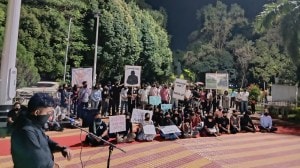Mohammadi is currently incarcerated in Iran, serving a 16-year sentence that began in 2015 over charges that include spreading propaganda against the state.

While announcing the award, the Norwegian Nobel Committee also referred to the 2022 protests in Iran, following the killing of a young woman named Mahsa Amini while she was in the custody of the morality police. The protests’ motto ‘Zan –Zendegi – Azadi’ (Woman – Life – Freedom) “suitably expresses the dedication and work of Narges Mohammadi”, the committee said.
In this regard, we look at a quote from Mohammadi — “Women will not give up. We are fuelled by a will to survive, whether we are inside prison or outside”. What did she mean by it and how is it a continuation of the women’s rights movement in Iran?
What is the full quote? What is its significance?
“Women will not give up. We are fuelled by a will to survive, whether we are inside prison or outside.”
This quote was posted on Mohammadi’s Instagram account as well as the official Nobel Prize account after her win was announced. It refers to both her life and work and the position of women in Iranian society. The quote is an effective call for continuing women’s struggle against patriarchy. In a few words, it illustrates the strength and determination of women to battle against all odds, in all kinds of circumstances, without giving up.
And while the sentiment has universal applicability, in feminist movements in other countries too, the quote is also reflective of Mohammadi’s activism that focuses on Iranian women’s rights.
Story continues below this ad
Who is Narges Mohammadi?
Born in 1972, Mohammadi comes from a politically active family– her relatives were imprisoned following the Iranian Revolution, which saw the country transition to a theocracy.
In an interview with The New York Times earlier this year, Mohammadi said that two childhood memories “set her on the path to activism” – her mother’s prison visits to her brother, and seeing her watch announcements on TV for the names of prisoners executed each day.
In the 1990s, Mohammadi made her voice heard through regular articles in newspapers, even as she established her career as an engineer. In 2003, she became associated with the Defenders of Human Rights Center in Tehran, an organisation founded by Shirin Ebadi – the first Iranian woman to win the Nobel Peace Prize back in 2003.
This is not Mohammadi’s first time in prison – that happened in 2011. However, even there she organised protests against the government along with other women prisoners. “Altogether, the regime has arrested her 13 times, convicted her five times and sentenced her to a total of 31 years in prison and 154 lashes,” the Nobel Committee said.
Story continues below this ad
In 2022, following protests after Mahsa Amini’s death, she organised solidarity actions. She has also campaigned vigorously against the death penalty and other harsh sentences meted out to prisoners in the country. Last year, her book ‘White Torture’ was published while she was briefly at home after a medical emergency. It focused on solitary confinement and included interviews with other Iranian women who had undergone punishment.
Iran and the struggle for women’s rights
The most recent example of Iranian women’s rights being in the spotlight was the months-long agitation that followed Mahsa Amini’s death in 2022. Women did not just take to the streets to vent their frustration but it was seen as a protest against years of regulations – there were reports of multiple women burning their headscarves in public spaces.
For context, Iran’s Islamic Republic requires women to cover up in public, a rule that includes wearing a hijab or headscarf that is supposed to completely hide the hair. Many Iranian women, especially in urban areas, have avoided following the rule to a T. This holds even more true for the younger generation, which has taken to wearing loose scarves and outfits that push the boundaries of conservative dress.
Protests over Amini’s death took place even in conservative cities like Mashhad or Qom, the latter being the historic centre of Iran’s clergy. Across the country, women were heard chanting, “Whoever kills our sister, we will kill them”. Despite the brutal suppression of the demonstrations by the regime, the movement managed to make its way to global discourse.
Story continues below this ad
Shirin Ebadi has also, in the past, argued that the feminist movement in Iran is the strongest in West Asia because Iranian women are highly educated. “Women make up over 60 percent of university students and play a role in all important aspects of society. Yet the Islamic Republic has discriminated against women and continues to discount their lives and rights. This has created a backlash and women have been pioneers in every protest. Democracy will be brought to Iran by strong women,” she said.
Iranian women also protested after the Iranian Revolution in 1979. After taking over the government, Ayatollah Khomeini announced on March 7 of that year that the hijab would be mandatory for women. Tens of thousands of women marched against the order the very next day, which just so happened to be International Women’s Day.
In a 2022 Associated Press report, Susan Maybud, who participated in those marches and then worked as a news assistant with the foreign press, said: “It was really the first counter-revolutionary movement… It wasn’t just about the hijab, because we knew what was next, taking away women’s rights.”
She added that in Iran, “What you’re seeing today is not something that just happened. There’s been a long history of women protesting and defying authority.” Mohammadi’s activism builds on that legacy.








































